One woman’s cruising…and learning…experience
This is the second half of a 2-part article by Daria Blackwell.
You can read part 1 here.
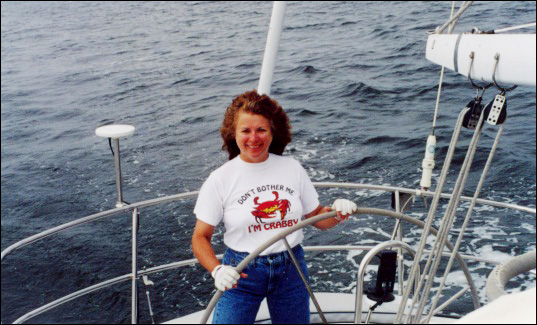 |
| Daria not crabby at all sailing along on Long Island Sound. |
Ratcheting up the confidence level
Fast forward to another time and life with Alex, my husband, friend and trusted partner in everything worthwhile.
Fast forward, too, to finding the courage to take the helm and learn a couple of lessons I’d like to share with you. Hopefully, it’ll help you avoid wasting decades of hard labor.
Here it is:
1) It is a lot easier than I ever imagined to handle a boat under most circumstances
2) It’s so much easier to be at the helm than
- hoisting and trimming the sails (“so long” to the ‘winching wench’)
- cooking under way (which is the only time I ever get seasick)
- dropping and weighing anchor (I know it weighs a lot)
- setting lines and fenders (and having to move them from one side to the other at the last moment when you find out they changed your slip assignment)
- jumping onto the dock from a pitching boat and muscling the boat into the dock against wind and tides.
If I had only known, I would have taken the helm years earlier and not let go.
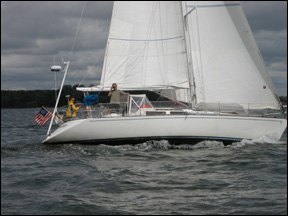 |
| ESPRESSO at 41 feet was a delight to sail even single handed. |
Experience and self confidence is what made all the difference. How did I get there? I planned to overcome my ‘shortcomings’ methodically.
Much like many women, I took lessons, read every book and magazine I could lay my hands on, went to boat shows and learned from those who are out there, like Lin Pardey, Amanda Swan Neal, and Beth Leonard. I met my all time heroine, Ellen MacArthur, at a party just after she finished a single-handed trans-Atlantic crossing. I realized if she could race across oceans single-handed then I could certainly handle cruising.
But I had to “do it” and prove it to myself first. As I mentioned, I had often taken the helm underway while cruising. I could tack and jibe, hold a course upwind and downwind, and otherwise manage a boat underway expertly. It was the starts and stops that were daunting for some odd reason.
Practice makes for confidence
I started by taking the helm while mooring, which turned out to be so ridiculously easy that I was startled. (Perhaps I’d learned from all the mistakes I’d witnessed over the years.)
Next, I practiced driving the boat forward and stopping it, then backing and stopping to see what it would do. I next attempted docking under power while the wind was calm, then worked my way to docking with the wind blowing, the tide running, and approaches more challenging – like coming in aft-to into a slip. Piece of cake. I was good at it. (Better than my husband but shhhhh don’t tell him.) In fact, I was always so prepared that it just seemed easy.
That’s when I realized that the reason many people have problems is that they come in unprepared. They don’t have their dock lines set, they are still fumbling with fenders, they come in too fast, and they don’t observe the natural forces – wind and currents. If you come in prepared, your chances of getting it right are pretty high unless nature takes its toll in conditions you couldn’t have predicted. Then, anyone would have difficulty. But that’s not the usual situation.
Ask yourself, what’s the worst that can happen? You’ll miss the mooring and have to try again. Just don’t foul the prop on the mooring line and you’ll be fine. Work your way up. Try docking in calm conditions, in slack water, going very slowly to learn how your boat behaves. Go a little faster if you lose steerage, slower if you’re uncomfortable. Don’t let anyone intimidate you. You’re at the helm. You’ll soon get a good sense of the boat’s momentum – how long it takes her to accelerate and slow down, both in forward and reverse. Drive her around in reverse in an empty harbor in both directions just to see how she acts. Most boats have a little sashay action (prop walk) in one direction which can act to your advantage if you know about it.
Once you get that one under your belt…contemplate what happens if the engine quits? What’s plan B? Can you sail her up to an unoccupied mooring without auxiliary power? You bet you can! It’s not so hard once you’ve done it. Just furl your headsail then point her into the wind, let the mooring come right alongside toward you. Walk toward it, pick up the line, walk it to the bow, secure the mooring line, and drop the sails. Piece of cake. Anchoring under sail is even easier.
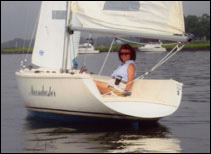 |
| Daria racing against her husband on an Ideal 18…the perfect small keelboat for confidence building. |
One thing that helped a lot was practice sailing up to a mooring and alongside a dock in a small keelboat, an Ideal 18, as part of a ladies racing program at our club. That was a tremendous confidence booster because I learned I could handle a boat without relying on the engine. It was another critical turning point. With this knowledge, I understood that it is not much different with a 41 foot sloop than it is with an 18 footer. The momentum is a little different but the principles are the same.
Now one of my biggest fears was conquered. If I couldn’t start the engine, I could still bring in the boat safely. Armed with this knowledge, I was free to sail on my own, without any supervision, and without relying on anyone else to bail me out if I got into trouble. And I could do it all on my own if I had to.
The last step was being out there by myself. The first time I went out for a sail alone on our Frers 41 was one of the most exhilarating experiences of my life. I was a little nervous I must admit, but more excited than nervous. It was a beautiful day. The wind was a steady 10 knots, the sky was blue, the sun was bright and the air warm. As I checked the oil, started the engine, and dropped the mooring lines, I felt this enormous sense of freedom. Then, I hoisted the sails, killed the engine, and headed out into the Sound. It was so quiet. I could do this. I could sail away all on my own, into my own world for a few hours and the world wouldn’t end. In fact, I liked it so much I kept going out on my own whenever I got the chance.
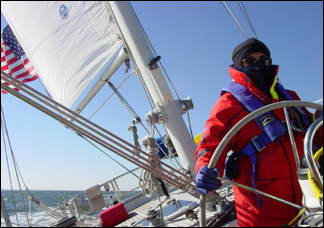 |
| Delivering ALERIA, a Bowman 57, to her winter home. Fall sailing at its best! Brisk and refreshing. |
The confidence coming from experience at the helm is what has made all the difference to me. The most surprising aspect is that I’ve recently learned that I have become a role model for friends and for women I don’t even know. I’ve had women come to me and say, “You’ve made me realize that I should have taken the helm long ago, if only for safety’s sake so I could do it if I had to.” I had no idea people were watching.
So where am I now?
Alex and I, with Onyx, sailed off across the North Atlantic from Nova Scotia to Ireland where we encountered six gales and avoided one strong storm. Then we crossed again to the Caribbean where we had a steering failure that took us 24 hours to fix. And on our third crossing back to Europe we had to motor a lot with little wind. I was at the helm responsible for our entire world for half the distance. I was essentially single-handing a 57-foot boat, because when I was on watch, Alex was asleep. I was in charge of our entire world and comfortable in that role.
I studied diesel mechanics and weather prediction. I obtained a long range radio license, CPR and first aid certifications, and advanced coastal navigation certificate. With each accomplishment, I checked off another misgiving. I practiced it all until I was comfortable sailing on my own.
I now have a 100 ton USCG captain’s license. I can’t just fix an engine, but I can diagnose a problem and figure out a solution. I can plot our way in the absence of electronics and in the presence of fog. I can operate any radio – VHF, SSB, and HAM. I can route us around weather systems, prepare for the worst when it arrives, and hopefully get us through it if we get caught in it. I’m not an expert in any of these things, but I am competent and confident in my ability to respond responsibly in a tough situation.
Today, Alex and I share it all.. We both need to know how to do everything on board – at least enough to deal with a problem. That way, if something happens to one of us, the other will still be able to get us to safety. And that goes both ways. I still do the provisioning, but I’m a helmsman, tactician, and navigator, and I can hold my own in discussions with tugboat, fishing boat and tanker captains.
If for no other reason than being able to get into port safely should you have to, you should always be willing to take the helm under normal circumstances and practice intimidating manoeuvres. I hope this top 10 countdown of reasons ‘why you should take the helm’ inspires you to grab that tiller or wheel the next chance you get.
Top ten reasons why women should take the helm:
10. You won’t have to cook under way (and someone else will be getting seasick below decks)
9. You’ll avoid all the work of setting and adjusting lines and fenders for docking, jumping onto the dock from a pitching boat, and muscling the boat into the dock against wind and tides.
8. Someone else will hoist the sails while you steer steadily into the wind
7. Your navigator will be running back and forth to check radar, read charts, find the next mark, plot positions, and get stuff to work while you keep a steady course and double check their work
6. No more winching…you’ll just calmly instruct the crew to tack, jibe, or trim
5. You won’t have to be flogged by sheets and sails because your crew will see to it if there’s a problem
4. You can impress the guys at the yacht club if you perform an expert manoeuvre while they’re watching
3. You can ask someone else to weigh the anchor
2. You can decide your own destination and timetable
1. No one can yell at you if you’re in charge
But seriously, the most important reason is so you can when you need to. See you out there! Remember the old, “Just do it!”
About Daria Blackwell
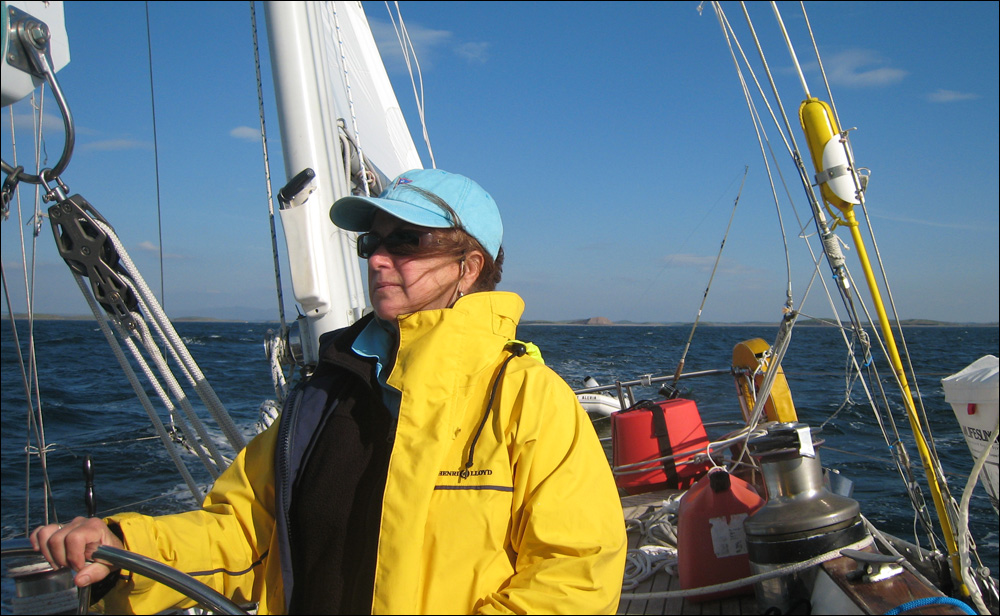
Daria Blackwell is a USCG licensed Captain. She and her husband Alex, and cruising kitty Onyx, have crossed the Atlantic three times in three years aboard their Bowman 57 ketch Aleria, spending years cruising the Caribbean and Atlantic islands as well as the American and European coasts. They are now in Ireland planning their next adventure.
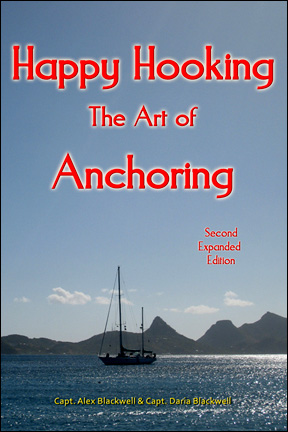 Daria is a proud member of the Ocean Cruising Club Committee, Seven Seas Cruising Association (cruising station for Ireland), American Yacht Club and Mayo Sailing Club.
Daria is a proud member of the Ocean Cruising Club Committee, Seven Seas Cruising Association (cruising station for Ireland), American Yacht Club and Mayo Sailing Club.
The Blackwells are co-authors of Happy Hooking – The Art of Anchoringwhich has received excellent reviews in the sailing press. They periodically conduct their Happy Hooking webinar for Seven Seas University.
Their website is www.CoastalBoating.net, “the boaters’ resource for places to go and things to know”.
Also on this website
- How we learn: All posts
- More posts by Daria Blackwell:
- Why it’s better for women to take the helm - Part 1
- Chance encounters between ships and whales Part 1 & Part 2
- Dancing in the Harbour
- What I like best about cruising? Passages and anchorages: a world of your own

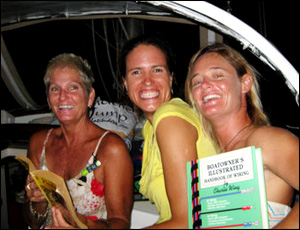
Excellent post. Its so intimidating at first but if we just get out there and do it all that intimidation floats away. Thanks for the read.
Linda Faubert
S/V DevOcean
Thanks for the kind words, Linda. You are so right. It’s intimidating to be parking a moving house in essence, but it’s not so bad once you get used to it. Much like stage fright, you get over it but still get a bit jittery every time. But it is very rewarding and the feeling of accomplishment is radical.